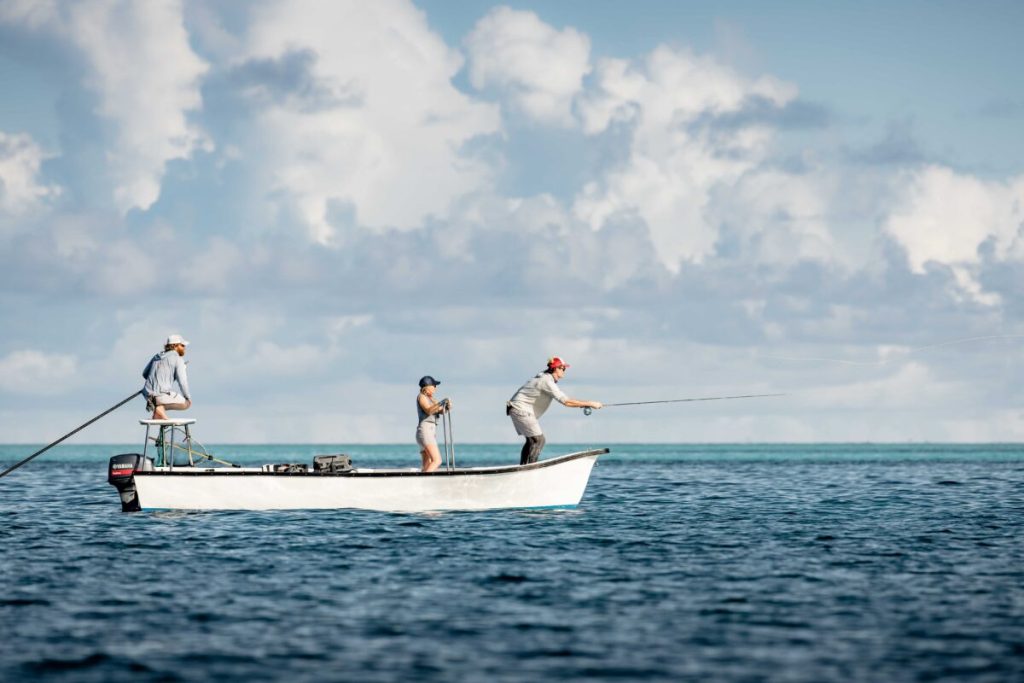If you are preparing for your first saltwater trip it’s useful to know what you need to practice beforehand. This is because the more efficient your casting is, the more effective you will be at catching fish. You’ll be surprised at how many people pay a few thousand pounds to go on the saltwater trip of a lifetime and don’t know how to double haul. Hopefully these saltwater fishing tips will set you in the right direction.
Saltwater Destinations
Most of the time these saltwater destinations don’t allow for dithering. Your guide will see the fish from the poling station or wading the flats and tell you to (quickly) place your fly in the direction of the shadow that is cruising the drop off, island, structure or flat.
You will need stealth; you will need casting force and precision.
These saltwater tips are based on my previous experience and I hope they will help those fishing from a skiff or wading the flats for the first time.

From a Skiff
If you are fishing from a skiff you’ll need to move quietly, first thing’s first: take off your wading boots. Fish are very sensitive and although they cannot hear your voice above the water, they can feel every single vibration in the water. So, any sudden movement in the boat like the drop of an object or stomping from the bow to the stern can and will alert them. Or, at least make them wary before you’ve even had a chance to make the first cast.
Line Management
Line management should always be one of your top priorities. Knots and tangle’s can be a nightmare, especially on a boat. That said, they can be easily avoided if you are aware of what’s going on around you every step of the way. When you pull the line off the reel make sure you reverse it. This means that you should make a clearing cast and retrieve it back beside you the right way round. When you are ready the line should be neatly piled next to you in the boat, not outside, as when you cast you will have unneeded drag on the water. Hold the tippet with the fly hanging down by your side whilst you wait for each fish opportunity.
The Clock System
Most guides will use the clock system; this is when they tell you that the fish is at 1 o’clock, 40 yards away. Imagine that you have a large clock in front of you but it is lying flat on the bow of the boat. 12 o’clock is straight ahead. Remember, the guide is at 6 o’clock, so don’t cast straight back – if you do, you’ll know about it! The guide will make sure he maneuvers the boat so that you can make the cast.
Wait for their instructions and always listen to your guide. They’ll tell you things like how fast or slow to strip and sometimes even when to strike and don’t cast at a fish if you can’t see it. It’s also important to keep low when you’re stripping line back because the fish can come all the way up to the boat and the less height you have on the skyline the better.

Casts
I use these casts to cope with the wind. You should always make sure you know which direction the wind is coming from!
- Side – This allows for a longer stroke and it helps that the wind is less down low than it is up high. Tilt the trajectory of your casting arc to the side. Tail wind – tilt back, head wind – tilt forwards
- Belgian/ Oval – This cast can help when using heavy saltwater flies because of the constant tension. If there is tail wind this is also great as you have a low angle back cast and a high finish.
- Roll cast pick up – This can help to elevate a heavy fly and/or line to the surface before going into your overhead or side cast. This saves bringing in all the line to make your cast.
- Barnegat Bay – (also known as back casting) another angle so you can cast off both sides of the boat, if the wind is coming into your casting shoulder it acts as a safety cast, which results in your fly always blowing away from you and not into you.
- Mangroves Cast – Get low, bend your knees and get the fly as far as you can into the vegetation. Especially good for species like snook. Be prepared to lose some flies. The more you practice the cheaper this cast will be!
Double Hauling Breakdown:
- Applying the single or double haul during your casting stroke increases your line speed. This increases both distance and speed to your target.
- Hauling helps deal with the wind more effectively. Hauling will make it much easier to cope with a head or tail wind
- The shorter the stroke the smaller the haul, the longer the stroke the bigger the haul. Your haul size depends on how much line you have out of the rod tip.
- Make sure that your hands come back together before the next haul is applied on the forward or back cast. When your line hand hauls away from your rod hand your line hand should bounce back to your rod hand straight away. As Mel Kreiger says “downup” – all one word.
- Fish come and go on the flats very quickly, so adding the haul can be the quickest and most effective way of getting your fly from A to B.
Whatever you do, DO NOT trout set, learn how to and practice the strip set.
All photos shot by The Fly Fishing Nation. All photos were shot on a trip with Alphonse Fishing Company, many thanks to them for making it happen!
Back to blogs